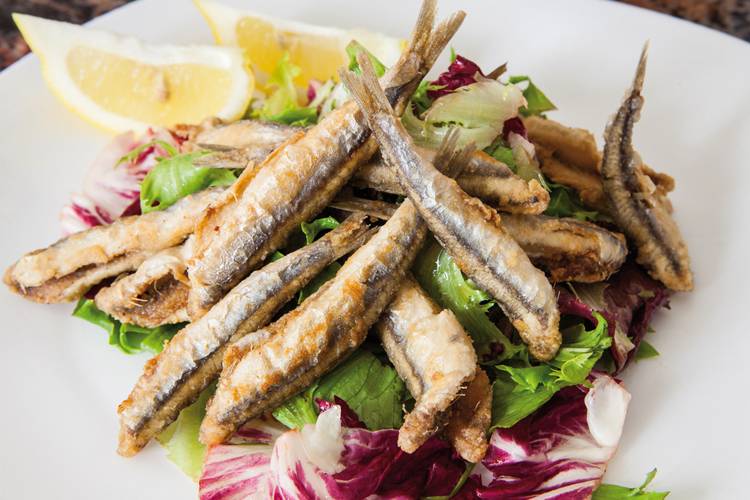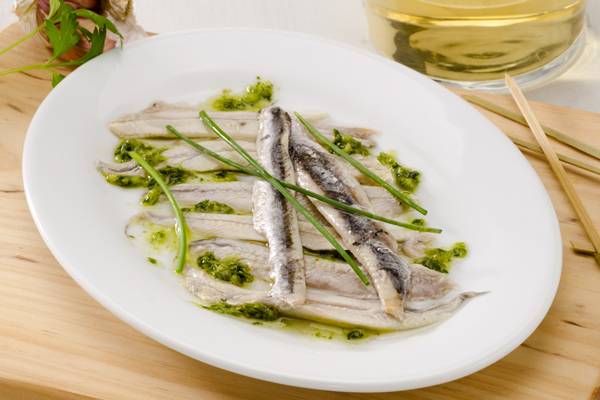The Anchovy
A blue fish that, along with horse mackerel, tuna and sardines, is one of the most consumed fish in Spain, because of how versatile it is in cooking and its affordability. According to its presentation, it is called various things, like “anchoa” (anchovy), which is what they are called in the north and centre of the peninsula, whether they are fresh or preserved.
fresh food
Share

The anchovy is a species found in the Pacific Ocean, Atlantic Ocean and in the Mediterranean and Black Seas, and lives at a depth of more than 100 metres. In the Spring and Summer, when the sun warms the surface water of the sea, shoals of anchovies rise to the surface levels to feed and reproduce. It is in this moment that they are caught, when they have gained weight and their meat is more fragrant and flavoursome. During Winter, they stay at a depth of more than 100 metres below sea level.
They are categorised according to where they live: so we have Japanese anchovies, and those from Australia, New Zealand and South Africa. However, the ones we buy in supermarkets are from this country, given that there is an abundance in our seas.
In Spain, the “anchoa” is technically the semi-conserved anchovy, whether that’s cured, in brine or oil, and usually the term “boquerón” is reserved for the fresh fish. It is also called “bocarte”, “European anchovy” or “aladroque”.
The anchovy, along with the sardine and horse mackerel, are the three most consumed blue fish in our country. The “anchoa” is the product we get from treating “boquerón” anchovies in salt, although in the North and central parts of the peninsula, the terms are used interchangeably, whether they are fresh or preserved.

Health benefits
The anchovy is a blue fish, and so is oily and rich in Omega-3, which helps to lower levels of cholesterol and triglycerides, and aid blood flow, which prevents blood clots. Consumption is recommended for people with cardiovascular issues.
In terms of vitamins, it contains many group B vitamins such as B2, B3, B6 and B9 and B12. In general, these vitamins help the body to process energy-providing nutrients such as carbohydrates, fats and proteins, and assist in the creation of red blood cells, and the functioning of the immune and nervous systems. However, the amount of the vitamins contained, with the exception of B12, is not significant when compared to foods rich in those nutrients such as whole grains, pulses, green-leafed vegetables or liver. As an oily fish, it has an interesting quantity of fat-soluble vitamins A and D:
- Vitamin A: helps to resist infections, necessary for development of the nervous system and for night vision. It also helps with bone growth and the production of enzymes in the liver.
- Vitamin D: regulates the levels of calcium in the blood and helps with the absorption and fixation of this mineral in bones.
In terms of minerals, anchovies provide magnesium (which helps the intestine, nerves and muscles to function well), and iodine (crucial for the proper functioning of the thyroid gland), and its average iron content is comparable to the majority of fish. If we eat them whole, including bones, mainly preserved, we benefit from the calcium contained in their bones. In fact, the quantity of calcium that 100 grams provides is similar to the amount in a glass of milk.
Anchovies and other preserved fish, in general, contain high levels of sodium, which is used as a preservative, and is not recommended for people with arterial hypertension or liquid retention problems. In addition, anchovies contain purine, which in the organism turns into uric acid, which is not recommended for people with hyperuricemia or gout.
Important: In Spain, the “anchoa” is technically the semi-conserved “boquerón” anchovy, whether that’s cured, in brine or oil. The term “boquerón” is reserved for the fresh fish.

Advice on purchase, conservation and cooking
When buying fresh anchovies, it must be taken into account that the meat will be firm, the eyes shiny and not sunken, and that its fishy smell will be light.
If it is going to be eaten the same day or the following day, it must be kept in the coldest part of the fridge, for no more than 48 hours after purchase, however it can be kept in the freezer for around 5 or 6 months. The best thing is to keep it separate from the rest of the food to make sure the strong smell doesn’t transfer.
In order to avoid allergies from anisakis, it is best to freeze the fish for more than 24 hours. That way, it can be eaten in the desired way, raw or semi-conserved in oil or vinegar.
Gastronomy
It can be prepared fried, baked, pickled, coated in flour, grilled, with lemon, in vinegar, with rice, in soup... The anchovy is prized in cooking in the countries of the Mediterranean basin because of its taste and gentle texture.
In Spain it is mostly eaten in three forms: coated in flour and then fried in olive oil; marinated in salt, garlic, parsley and olive oil, or as a semi-conserve, dry salted and covered in olive oil.
According to its presentation and the region where it is found, this fish is called different things. In Cantabria, it is called “anchoa” when it is cured and stored in olive oil, or “bocarte” when it is coated and fried. All along the Mediterranean coast, and on Andalucia’s Atlantic coast, it is known as “boquerón” whether it is prepared in a flour coating and fried, or marinated in vinegar (boquerón in vinegar), olive oil, garlic, parsley and salt. In some countries, such as England the meat of the anchovy is usually cured to make a flavoursome paste called Gentleman's Relish.
From our web page to your kitchen
Brocolli pasta with anchovy sauce.
Cottage cheese toasts with anchovies.






